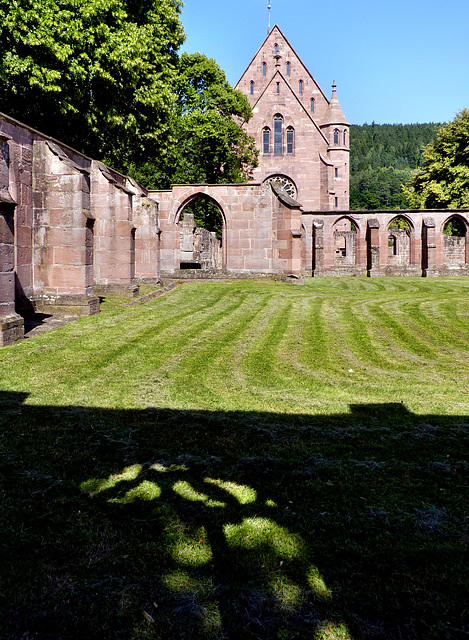Hirsau - Abbey
Hirsau - Abbey
Hirsau - Abbey
Herrenalb - Abbey
Klosterreichenbach - Monastery
Klosterreichenbach - Monastery
Klosterreichenbach - Monastery
Klosterreichenbach - Monastery
Klosterreichenbach - Monastery
Klosterreichenbach - Monastery
Klosterreichenbach - Monastery
Heselbach - St. Peter
Heselbach - St. Peter
Mummelsee
Oppenau - Kloster Allerheiligen
Oppenau - Kloster Allerheiligen
Glottertal - St. Blasien
Freiburg - Muenster
Freiburg - Muenster
Freiburg - Muenster
Freiburg - Muenster
Breisach - Muenster St. Stephanus
Schwarzach - Saints Peter and Paul
Hirsau - Abbey
Hirsau - Abbey
Hirsau - Abbey
Hirsau - Abbey
Hirsau - St. Aurelius
Hirsau - St. Aurelius
Hirsau - St. Aurelius
Maulbronn - Monastery
Maulbronn - Monastery
Maulbronn - Monastery
Maulbronn - Monastery
Maulbronn - Monastery
Maulbronn - Monastery
Maulbronn - Monastery
Maulbronn - Monastery
Maulbronn - Monastery
Maulbronn - Monastery
Maulbronn - Monastery
Maulbronn - Monastery
Maulbronn - Monastery
Maulbronn - Monastery
Maulbronn - Monastery
Location
See also...
Keywords
Authorizations, license
-
Visible by: Everyone -
All rights reserved
-
149 visits
Hirsau - Abbey


Twenty years after Pope Leo IX had asked his nephew Count Adalbert of Calw to rebuild the ruined abbay St. Aurelius, this abbey got a young abbot. Wilhem von Hirsau (aka "William of Hirsau"), educated at St. Emmeram in Regensburg, a very well known "thinktank". Immidietly tried to gain independence of all secular powers for the abbey. At that time, he was probably influenced by the idea, that had spread from Gorze Abbey in Lorraine. He was a strong supporter of the Pope during the Investiture Controversy. Already in 1082 he commissioned the building of a new monastery on a nearby high plateau. In 1091 the abbey church, modelled on Cluny II and dedicated to Peter an Paul, got consecrated.
The convent followed 1092 and moved into a monastic compound designed according to the Plan of Saint Gall. Wilhelm´s friend Ulrich (aka "Ulrich von Zell", "Ulrich von Cluny"), a schoolmate from St. Emmeram, had made carreer in Burgundy and was an advisor to Abbot Hugh of Cluny. So the Cluniac reform found their way into the Black Forest. Based on them Wilhelm wrote down the "Consuetudines Hirsauginenses". Known as the "Hirsau Reforms", the adoption of these rules revitalised Benedictine life throughout Germany - and were followed by far more than 100 monasteries.
Based on a thriving economy most of the romanesque buildings (but not the church!) were demolished and got replaced by gothic style structures. Shortly after that, the Reformation put an end to the abbey in 1536, when the monks had to leave - and a Protestant school was opend here (just like in Maulbronn!).
The "Duke of Wuerttemberg" replaced the old abbot´s house by a posh hunting palace around 1590.
During the Nine Years' War (aka "War of the Palatine Succession") the infamous General Ezéchiel de Mélac burnt the abbey down (like he did with Heidelberg, Worms, Speyer..). The ruins were used as a quarry - and so there is not really much left of this great and important abbey.
As the ruins of the large Gothique cloister are dominating the area, the are seen on the most photos taken here. The Lady Chapel in the back got renovated and rebuilt late 19th century and since then serves the Protestant parish.
The convent followed 1092 and moved into a monastic compound designed according to the Plan of Saint Gall. Wilhelm´s friend Ulrich (aka "Ulrich von Zell", "Ulrich von Cluny"), a schoolmate from St. Emmeram, had made carreer in Burgundy and was an advisor to Abbot Hugh of Cluny. So the Cluniac reform found their way into the Black Forest. Based on them Wilhelm wrote down the "Consuetudines Hirsauginenses". Known as the "Hirsau Reforms", the adoption of these rules revitalised Benedictine life throughout Germany - and were followed by far more than 100 monasteries.
Based on a thriving economy most of the romanesque buildings (but not the church!) were demolished and got replaced by gothic style structures. Shortly after that, the Reformation put an end to the abbey in 1536, when the monks had to leave - and a Protestant school was opend here (just like in Maulbronn!).
The "Duke of Wuerttemberg" replaced the old abbot´s house by a posh hunting palace around 1590.
During the Nine Years' War (aka "War of the Palatine Succession") the infamous General Ezéchiel de Mélac burnt the abbey down (like he did with Heidelberg, Worms, Speyer..). The ruins were used as a quarry - and so there is not really much left of this great and important abbey.
As the ruins of the large Gothique cloister are dominating the area, the are seen on the most photos taken here. The Lady Chapel in the back got renovated and rebuilt late 19th century and since then serves the Protestant parish.
- Keyboard shortcuts:
Jump to top
RSS feed- Latest comments - Subscribe to the comment feeds of this photo
- ipernity © 2007-2024
- Help & Contact
|
Club news
|
About ipernity
|
History |
ipernity Club & Prices |
Guide of good conduct
Donate | Group guidelines | Privacy policy | Terms of use | Statutes | In memoria -
Facebook
Twitter

Sign-in to write a comment.